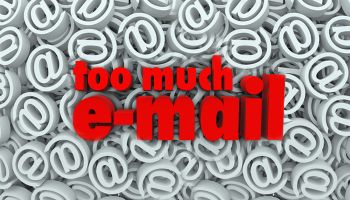10 "rules" for better business email
The guide you’ll wish they gave out 1 million emails ago
- |
- Written by Sharlyn Lauby

Editor’s Note: When you’ve finished reading Sharlyn Lauby’s ten rules, please add your own rules in the comment section at the end of this article.
There’s been a lot of talk over the years that email is dying and/or dead.
That may be true. I can definitely see a time when email isn’t part of our business communications.
But we’re not there yet. Given how much email we generate, email is experiencing a long, drawn-out, painful death.
And it often amazes me that there isn’t more conversation about the rules of email. We have structure around the way we craft resumes, write business letters, and use social media.
Email? Not so much.
Yet nothing frustrates people more than when others break what are considered the accepted rules of email. So I decided to put together a list of the top ten things that business people expect in email communications.
Now, you’ll notice that I’m not going to include typing in ALL CAPS as one of the rules on the list. I’d like to believe we’re past that. Although, I do still get a few …
The 10 rules of email
1. Email is not a meeting substitute.
Meetings happen for specific reasons—to convey information, to solve problems, or to make decisions. Some of those things can be accomplished via email. Many cannot. The last thing we want to do is start a conversation via email and then, after lots of emails start flying around, call a meeting to actually deal with the issue.
2. Some messages are better voice to voice (whether that’s in person or over the phone).
Difficult messages are best delivered when people can hear your voice. We know it’s a tough message. And we know that personal delivery isn’t designed to be punishment. It’s to show sincerity and let the person know they are important.
3. Devise several auto-signatures.
Consider having a signature for new emails and an abbreviated version for replies. One for your primary work and another for your side hustle. Possibly a different one for personal emails. People today have multiple emails so add a layer of customization to your auto-signature for each audience.
4. Change the subject line when you change the subject.
Readers prioritize responses by using the subject line. Help the reader give you a timely response by changing the subject line when you change topics. You’ll get the info you need, when you need it.
5. Learn how to use the CC and BCC functions.
If a person is expected to reply, their name should be in the “To” line. The CC line is to keep others informed. The BCC line is to keep others informed without everyone knowing.
The biggest challenge with BCC is people who hit reply all and make a comment. No one was supposed to know that they knew. Which leads me to the next rule…
6. Ineffective use of the “Reply All” button will kill your career. Same with Read receipts.
People get angry at their co-workers who excessively use the reply all button.
Or who send every email with a read receipt. Occasionally, that’s fine.
There are times when both are appropriate and necessary. But not all the time.
7. Use spell check.
Then realize at some point, we will all send an email with a typo.
Here’s my small rant about grammar. I sincerely believe that everyone tries to use proper grammar. And we should read our emails before sending to make sure we don’t have any typos. Even though we do those steps, we will occasionally have a typo. I’m not justifying them. Just pointing out that we are human.
8. Not responding to an email is not the same as saying no.
Individuals who avoid answering emails thinking the issue will go away … well, that really doesn’t happen.
People get smart. They start sending emails saying “If I don’t hear from you by Thursday, I’m going to do this …”
That is a strategy to force an answer. Or get a tacit approval. If you don’t want to send a “no” email, see rule #2.
9. Set a reasonable expectation for replies.
It’s not 10 minutes. Even when you have a smartphone.
I once did a focus group where people said 24 hours was a reasonable time to reply to an email. If it’s going to take a couple days to research an answer, let the person know.
Email is a communication medium. It’s not designed to drive people crazy with urgent requests.
10. “I never got your email.” isn’t a technology issue. It’s an avoidance technique.
Well, maybe I’m being a bit harsh here. There are moments when email doesn’t work.
But in today’s business world, we should know to check our junk folders regularly, especially when we are expecting a reply. Habitually using the line “I didn’t get the email” is an indicator of something else.
Email may very well die someday, but that’s not an excuse to do it poorly while it’s still drawing a breath.
Editor’s Note: This article originally appeared on Sharlyn Lauby’s own blog,
“HR Bartender.”
Tagged under Human Resources, Management, CSuite, Feature,














